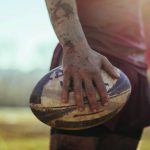Slowed reaction times while the brain recovers may increase the risk of other injuries, experts say.
Specialists are urging patients with concussion to delay their return to sport for at least a week – if not a month – after symptoms resolve, citing evidence of ongoing neurocognitive inhibition and increased risk of musculoskeletal injury.
Sporting head traumas have recently made headlines with high-profile cricketers Cameron Green and Will Pucovski both copping blows to the head in the past week. It is Pucovski’s ninth concussion.
This comes as a review of football fatalities finds that while most deaths from head, neck or abdominal injuries have substantially decreased, traumatic brain injury-related deaths have made a resurgence in the past decade.
Associate Professor Alan Pearce, a neurophysiologist at LaTrobe University, told TMR that recent research suggested symptom resolution after a concussion did not necessarily equal brain recovery.
“What we’re seeing is that some of the underlying neural mechanisms may not have fully recovered even when a patient may not report or show any overt symptoms after their concussion,” said Professor Pearce, who is the Victorian research manager at the Australian Sports Brain Bank (ASBB).
One week off was a good blanket rule, but three to four weeks was preferable, Professor Pearce said.
“Research is telling us it’s taking 28 to 30 days. So, if a player is concussed on a Saturday game and they see the doctor on Monday or Tuesday and don’t show any symptoms … don’t just clear them on the spot. Try to at least give them one week off before clearing them to return to contact training and playing.”
A possible incentive to rest was the two- to three-fold increased risk of injuries such as a rolled ankle after concussion, Professor Pearce said.
“If an athlete is concussed, their risk of musculoskeletal injury is actually significantly increased.
“We don’t really understand why, but what we’re seeing in the research is the neural circuitry hasn’t fully recovered – so they might be 100 milliseconds slower in their reaction time, which could be the difference between keeping playing, and rolling their ankle or damaging their shoulder.”
Female patients may also need longer recovery times than males, Professor Pearce said.
“We need a lot more research in women athletes, but the emerging research is showing women athletes with concussions show more, and more severe, symptom reporting than males, and will take longer to recover as well, which we are trying to understand the reasons behind.”
However, he encouraged GPs to interrogate men about symptoms as studies had shown they were more likely to underreport than women.
GPs are also well-placed to watch for warning signs of longer-term issues associated with concussion.
Neurologist and ASBB clinical co-director Dr Rowena Mobbs said anyone with a history of repeated head trauma should see their GP if they or family and friends have concerns.
“In addition to symptoms post-concussion and with migraine complicating head trauma, the types of symptoms that would raise concern are: memory loss, especially short-term recall impairment; change in mood towards anxiety, depression, irritability, mood dysregulation with easy anger or rage; socially inappropriate commentary or behaviour; and a picture of decline,” said Dr Mobbs, who is also a senior lecturer at Macquarie University.
“Studies overseas would suggest that even two years of repeated head trauma may be enough to associate with traumatic encephalopathy syndrome, the clinical correlate to chronic traumatic encephalopathy (CTE).”
Review by an expert in cognitive assessment, such as a neurologist, geriatrician, neuropsychiatrist or neuropsychologist, might be helpful.
“An MRI of the brain is a helpful investigation for excluding other causes, and occasionally volume loss or gliosis are detected. Microvascular changes within the white matter are commonly seen in those with dementia, particularly Alzheimer’s disease and increasingly in CTE,” Dr Mobbs said.
Macquarie University also offered a clinical program with integrated specialist review, and a support group met every second month for those with possible or probable CTE, she added.
Since 2016, the National Football League in the US has formally acknowledged a link between football and CTE, but the evidence for CTE as a distinct disease continues to be debated by major sporting bodies in Australia.
To tackle this, specialists at the ASBB are calling for any patients with a history of concussion to take part in their research regardless of whether they have experienced ongoing symptoms.
“One of the big criticisms of the [CTE] research is that the sampling is biased because only those who have ongoing concerns come to be involved in research,” Professor Pearce said.
“We do research right from those who are concussed in that first week through to people with post-concussion syndrome, and retired athletes.
“We’re trying to understand whether there are differences between those who have similar histories of concussion injuries that may give us a key to why some are struggling, and others are not.”
The MJA has just published a historical review of fatalities resulting from football-related injuries (including AFL, rugby, and soccer) reported in Australian media. It found 295 deaths in the past 146 years, with most (128 deaths) due to traumatic brain injury, and most occurring in community-level sport.
The authors, led by the Olympic Park Sports Medicine Centre, said while most deaths from head, neck or abdominal injuries have substantially decreased, traumatic brain injury-related deaths have made a resurgence in the past decade.
“This highlights the need to accurately report catastrophic events, protect players from head-high contact, and improve emergency responses at the community level,” they wrote.



